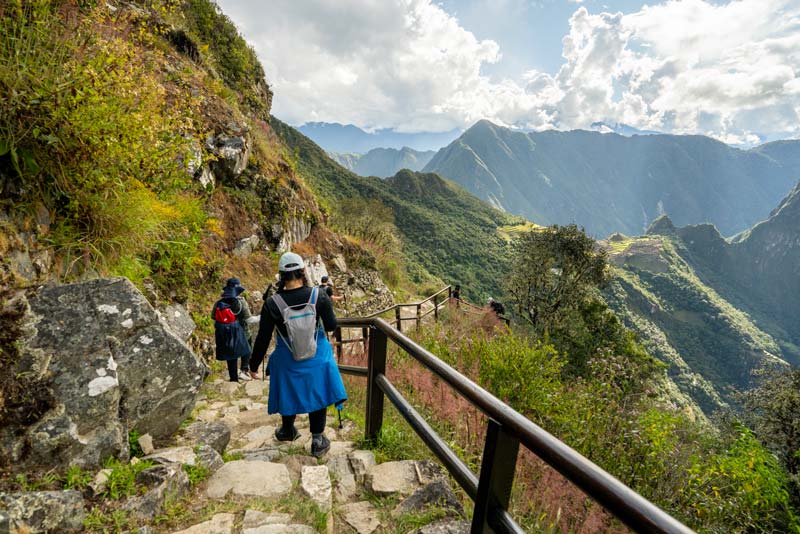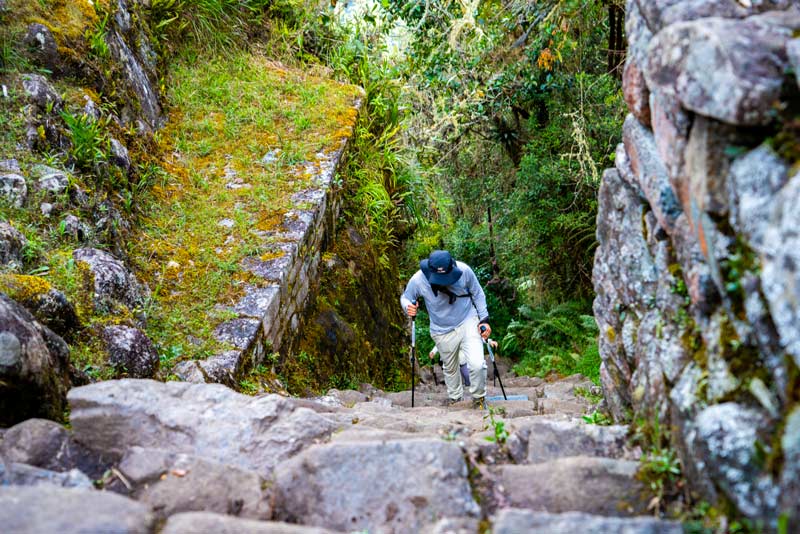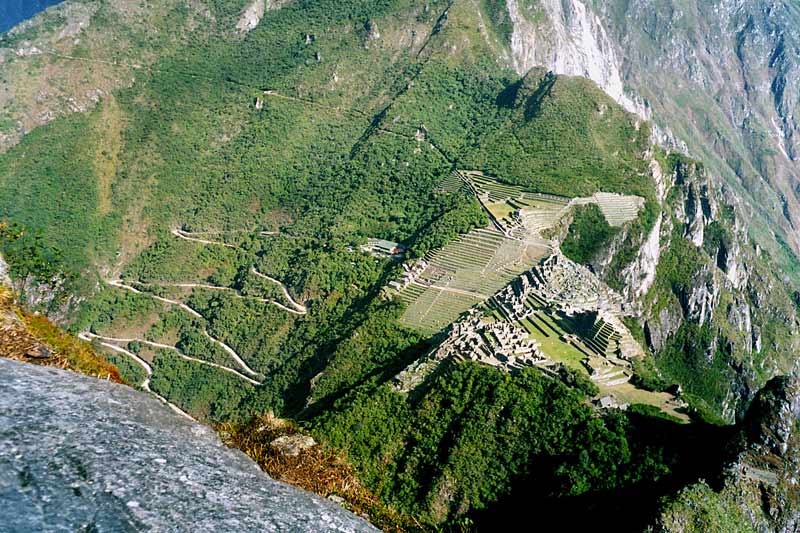Climbing Huayna Picchu after doing the Inca Trail?
There are two adventurous alternatives par excellence in the Wonder of the World: the first is the amazing 4-day trekking route to Machu Picchu known as the Inca Trail. The second is the ascent to the top of Huayna Picchu mountain, considered one of the most incredible short hikes in the world. Many tourists, after living the experience offered by the Inca Trail want to experience the adrenaline of the Huayna Picchu. Is this possible? Here is a guide to experience the two most incredible alternatives of the Inca Citadel.
- The Inca Trail
- The Huayna Picchu
- Climbing Huayna Picchu after the Inca Trail?
- Recommendations
- Other adventurous alternatives
- Frequently Asked Questions
To visit Huayna Picchu Mountain after the Inca Trail, it is recommended to book the Machu Picchu + Huayna Picchu (Route 3A) Ticket in Group 2. For both adventures, entrance tickets must be booked up to 6 months in advance in both cases.
The Inca Trail
The Inca Trail is a trekking route of 4 days and 3 nights to reach the Inca Citadel of Machu Picchu through the Sun Gate or Intipunku. In total, the route is approximately 43 kilometers through the ancient network of roads built by the Incas more than 600 years ago.
The adventure begins in the town of Pisqacucho, a small village in the middle of the railroad that leads to Aguas Calientes or Machu Picchu town. From there, the visitor travels through places at the foot of imposing snow-capped mountains such as the Warmihuañusca pass at 4,200 meters above sea level. As you descend, you will reach places with flora and fauna typical of the subtropical region that precedes the arrival to the Wonder of the World. On the fourth day, around 8:00 a.m., the visitor finally arrives at the Inca site.
It is estimated that 25,000 tourists hike the Inca Trail each year. It is not possible to do it on your own. To experience this adventure, it is necessary to reserve an entrance fee up to 6 months in advance. The 4-day hike includes an official tour guide, food, lodging in camps and porters who carry the tourist’s luggage on their backs. The Inca Trail is considered among the 5 best trekking routes in the world.
The Huayna Picchu
Huayna Picchu is the summit located north of the Inca citadel of Machu Picchu. It is located at 2,720 meters above sea level, almost 300 meters above the Inca site. It is known as the ‘young mountain’, as opposed to the Machu Picchu mountain (old mountain). The ascent to the top of this summit is considered one of the most incredible short hikes in the world.
The entrance gate to Huayna Picchu is located inside and to the north of the Inca Citadel. Ancient Inca trails lead to the top of this vertical mountain. The ascent is popular because of the adrenaline rush tourists experience as they climb the difficult and steep Inca trails on the edge of frightening cliffs. From the top of Huayna Picchu, the splendor of the landscape surrounding the Wonder of the World can be appreciated. In the mountain of Huayna Picchu, you can also find the Temple of the Moon, this enclosure can be reached by following the descent route. In addition, you can only do this route with the Machu Picchu + Temple of the Moon (Route 3C) ticket.
The only way to enter Huayna Picchu is by booking the Machu Picchu + Huayna Picchu (Route 3A) Ticket. This ticket allows the entrance of only 350 people per day so it is recommended to book tickets months in advance. Visitors can enter the mountain in two groups or schedules:
- Group 1: Enter Machu Picchu between 07:00 a.m. and 07:45 a.m. (Visitors can stay at the Wonder of the World until 01:00 p.m.)
- Group 2: Enter Machu Picchu between 09:00 a.m. and 09:45 a.m. (Visitors can stay in the Wonder of the World until 02:00 p.m.)
Climbing Huayna Picchu after the Inca Trail?
Visitors who wish to climb the Huayna Picchu mountain after the Inca Trail you must book the entrance ticket Machu Picchu + Huayna Picchu (Route 3A) in schedule 2 (entrance from 9:00 to 9:45 for Machu Picchu). It is important to take the second schedule because when you arrive at Machu Picchu after following the route of the Inca Trail, you will need some time to rest and start the tour again, but this time with the route to Huayna Picchu that also follows the paths of the Qhapac Ñam.
To do both the Inca Trail and the ascent of Huayna Picchu mountain, a lot of planning is needed. The first thing to do is to make both reservations months in advance, especially if you plan to do the adventure during the high tourist season (April to October). If you plan to visit during the low tourist season (October to March), you should keep in mind that the Inca Trail is closed for maintenance throughout the month of February.
Visitors who enter the Huayna Picchu mountain through Group 2, can stay until 02:00 pm. in the Inca site. This provides the opportunity to have time to visit the stone constructions of the Inca Citadel, such as the Temple of the Condor, the Temple of the Sun or the Inca House. If there is not enough strength left to continue walking through the Wonder of the World, another option is simply to enjoy the incredible view that Machu Picchu offers.
About admission tickets during the high season
Machu Picchu’s peak season runs from June 19th to November 2nd. During this time, there’s greater availability and new entry tickets to other destinations. Among the destinations available during peak season, we can purchase:
- Machu Picchu with Inti Punku (Route 1C)
- Machu Picchu with Inca Bridge (Route 1D)
- Machu Picchu with Temple of the Moon or Great Cavern (Route 3C)
- Machu Picchu with Huchuy Picchu (3D Route)
Recommendations
- Before doing the Inca Trail, it is advisable to acclimatize beforehand (1 or 2 days) in the city of Cusco. The tour through the ancient Inca trails crosses altitudes of up to 4,200 meters above sea level.
- The Inca Trail is open to people of all ages. The Huayna Picchu, only to people over 12 years old.
- For both the Inca Trail and Huayna Picchu it is recommended to bring sunscreen, water in a canteen, appropriate footwear for hiking, mosquito repellent, light clothing during the day and snacks.
- You do not need to be an expert mountaineer to do the Inca Trail and the Huayna Picchu ascent. The only requirement is the desire to reach the goal.
- The Inca Trail and Huayna Picchu have signs that protect the tourist’s life. It is necessary to follow the signs and not look for the trail on your own.
Other adventurous alternatives
- 2-day Inca Trail: An alternative for people for whom 4 days of trekking seems too much. This short version of the Inca Trail does not start at kilometer 104 of the road leading to the town of Aguas Calientes and only lasts 2 days and 1 night.
- Salkantay Trek: An adventure alternative for people who did not get the entrance ticket to the Inca Trail. This trek crosses the slopes of the imposing Salkantay mountain at 6,710 m.a.s.l. and then descends to Machu Picchu through the town of Aguas Calientes. It lasts 5 days and 4 nights.
- Trek to Machu Picchu Mountain: An alternative for people who did not get the entrance ticket to Huayna Picchu. This is a hike up to the top of Machu Picchu Mountain located inside the Wonder of the World. The view from the top is just as spectacular as from the highest point of Huayna Picchu.
Frequently Asked Questions
1) Is it possible to hike the Inca Trail and then climb Huayna Picchu on the same day?
Yes, it is possible. However, those arriving at Machu Picchu via the Inca Trail must additionally purchase the “Machu Picchu + Huayna Picchu (Route 3A)” ticket.
2) How many people can enter Huayna Picchu per day?
Access to Huayna Picchu Mountain is limited to 350 people per day, divided into two groups with specific entry times.
3) Can you do the Inca Trail without a guide or on your own?
No, the Inca Trail can only be hiked with an authorized agency that provides an official guide, porters, food, and campsite accommodations. This measure seeks to preserve the natural and archaeological heritage of the route.
4) When is the Inca Trail closed?
Throughout the month of February, the Inca Trail remains closed for maintenance and conservation work.
5) What is the minimum age required to climb Huayna Picchu?
Admission is only permitted to persons over 12 years of age. This is due to the difficulty and risks of the trail.
6) What is the difference between Huayna Picchu and Machu Picchu Mountain?
Both are mountains that offer impressive panoramic views of the Inca Citadel, but they have differences, Huayna Picchu is steeper and more adrenaline-filled, while Machu Picchu Mountain is longer and less steep.
7) How difficult is the climb to Huayna Picchu?
The hike is short but demanding, requiring good physical fitness, as there are very steep sections, with high steps and areas close to cliffs.
8) What alternatives are there if I cannot get into the Inca Trail?
A very popular option is the 5-day, 4-night Salkantay trek, which also includes Machu Picchu. Another alternative is the shorter 2-day Inca Trail.
9) Can I visit the Temple of the Moon next to Huayna Picchu mountain?
Yes, but only if you have the Machu Picchu + Huayna Picchu ticket (Route 3C).
10) When is the best time to do these routes?
The best time to visit is from April to October, during the dry season. These months offer clear skies and safer roads.
Advice from people who have been there
 By: Victoria M.
By: Victoria M.“Beautiful experience!“
“After doing the Inca Trail and touring a little of the citadel of Machu Picchu, we were delighted with the ascent and descent of the mountain. The ascent is tiring and the descent is vertigo-inducing. For those who do not suffer at altitude, I recommend it. The view you get at the highest point of the mountain is magical and unparalleled. It is worth the physical effort. With serenity you reach the top. I would climb it again.“
By Ticket Machu Picchu – Last updated, June 10, 2025



